With surprising frequency New Mexico license plates are found to be offered for sale under false pretenses as to what the plates actually are. In some cases this is simply a result of ignorance on the part of the seller as to what he or she is selling. But in other instances the representations are deliberate fraud on the part of the seller, committed with the intention of extracting the highest possible price from the buyer for something that has far less value—or in some cases no value at all. And it has not been unusual that in both circumstances the seller, even when advised of the misrepresentation, persists in huckstering the plate or plates under the false description.
Described and illustrated here are some the best known examples. If you know of additional examples, and especially if you have been a victim of a scam of this nature, please contact us with details and photographs so that we might include them on this web page.
And what should you do if you find you’ve been scammed? Even if the incident occurred long ago, contact the seller and demand a refund. Second, report the seller to the sale or auction site where the scam was perpetrated. If the scammer is a member of the Automobile License Plate Collectors Association (ALPCA), report the incident to the Complaints Chairman.
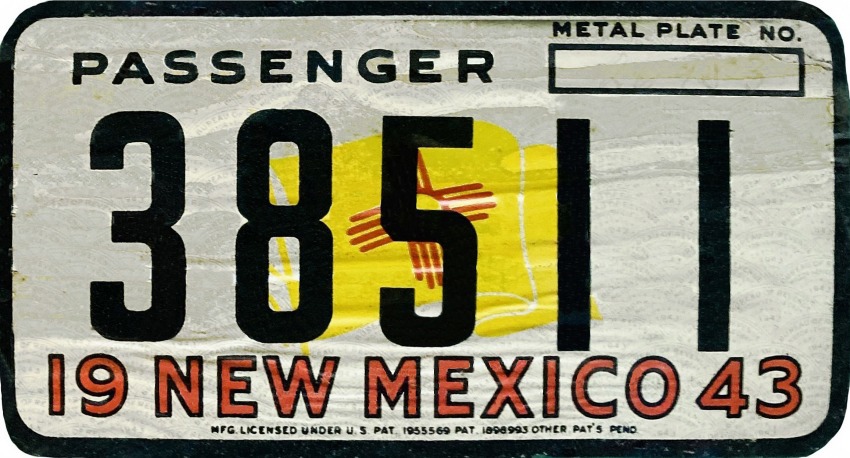
Though the original intent in making the prints may have been entirely innocent, that has not stopped other people from knowingly or unknowingly offering them for sale as genuine originals, often at staggeringly high prices. Below is a guide to distinguishing the copies from the authentic originals.
The originals are very thin translucent water-release decals. The copies are opaque glossy photographic prints, with thickness typical of those made by color photo print shops.
Originals are about 3" x 5-¼", as measured from the outside of black border. The copies are generally noticeably smaller.
All of the known copies bear the serial number 38511, and handwritten very faintly in the “METAL PLATE NO,” block is the number 26-953. While these numbers match that of the original from which the photo copies were made, there is only one original with these numbers, but many, many copies of it.
Because of the composition and fragility of the originals, along with the passage of time (now more than 80 years!), some of the originals have tended to develop wrinkles. While the photo copies show these wrinkles, the photos themselves are perfectly smooth on the surface.
Photos of genuine 1943 windshield stickers can be seen here.
Fraudulently Represented as the Real Thing
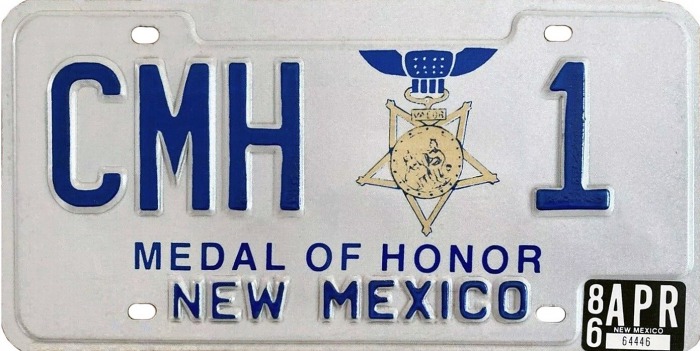
On the other hand a significant number of Medal of Honor sample plates were manufactured and used primarily for display purposes in Motor Vehicle Division field offices. The serial number on all of these samples is either CMH-1, where CMH stands for Congressional Medal of Honor, or MOH*1, where MOH stands for Medal of Honor, and “*” is the zia symbol. (There has never been a Medal of Honor recipient in any state with the initials CMH or MOH.) It appears that something on the order of several hundred of these samples were made and distributed.
These samples are illustrated in the DMV's 1984 license plate pamphlet TAS-10263 which you can see here and on the MVD’s June 1993 MVD-10264 license plate description card, a full color copy of which you can see here.
Over the years a number of these samples have been put up for sale via on-line auction sites and other venues at prices ranging from $500 to $1,500 or more, with some of the sellers coyly professing, “I don’t know who the Medal of Honor recipient was to whom this plate was issued.” Well of course they don’t, because there was no medal recipient who was issued a sample plate, and there was no medal recipient whose initials are "CMH" or “MOH.” Perhaps bilking someone out of $1,500 for a plate worth no more than $10 is too much to resist.
Motorcycle License Plates
The fact that these permits were stamped out on motorcycle license plate blanks, and used the same dies as on motorcycle plates, proved to be an open invitation for people to later put the permits up for sale while conniving to misrepresent them as “handicap motorcycle license plates.” They are, of course, nothing of the kind, nor are they motor vehicle license plates of any kind.
The MVD went out of its way more than thirty-five years ago to debunk this notion, stating in its New Mexico License plates – 1984 Edition publication that “THIS IS NOT A HANDICAP MOTORCYCLE PLATE” (caps are in the original). Notwithstanding the MVD’s efforts, hardly a day goes by without one or more of these permits being hawked through internet auction sites as handicap motorcycle plates at prices of up to $50 or more.
An actual handicap motorcycle plate is illustrated to the right of the parking permit illustrated above.
Different but similar versions of these permits were issued over the years, several of which can be seen here:
: https://nmplates.com/HandicapParkingPermits.htm
To see the 1984 MVD publication mentioned above, go to:
https://nmplates.com/PlatePamphlets.htm#1984-14
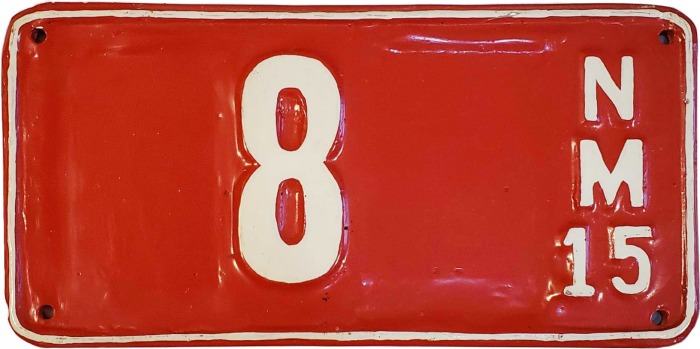

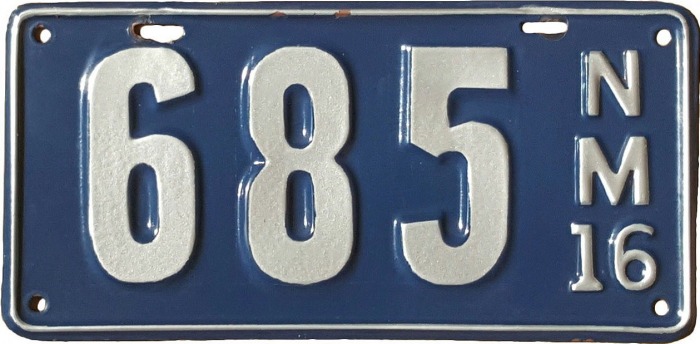
“Restored in the Correct Colors”
.jpg)
“Thick” variety 1918 plates were made of much heavier steel and have serial numbers that begin somewhere in the 13000 to 14000 range, continue up to about 19000, and have original colors of dark navy blue―almost black―numerals and letters on an olive background. Something on the order of a thousand or more of the thick variety tags, mostly in the 18000 serial number range, were left over at the end of the 1918 registration year and were apparently discarded, then found years later in badly rusted condition.
Many dozens, and probably hundreds of these rusty “thick” plates―not just those in 18000 series―are in circulation today, a great many of which have been “restored.” In these restorations, grossly incorrect colors were used, to wit, baby blue on light grey, rather than the correct colors of dark navy on olive. Moreover, in the restorations the raised rim was painted in the same baby blue as was used on the raised characters, even though the rim is not painted on originals of either the thin or the thick varieties.
Time and again these incorrectly painted 1918 plates come up for sale with the patently false claim that they are “restored in the correct colors.”

When a seller claims that a porcelain plate is “all original” he or she is usually representing that the plate (1) does not have any chips covered over with paint, (2) if the plate originally had a date tab, it is still present, (3) if it does have a date tab, the tab is the same one originally issued with the plate, and (4) the tab has not been repainted.
With that in mind, what is wrong with the 1922 plate #39969 illustrated above? The answer is that the porcelain plate itself, #39969, was not even issued until 1923, and therefore could not possibly have had a 1922 tab on it when it was in use. In other words, it is by no means “all original.”
Date tabs on New Mexico porcelains are frequently found to have been moved from one plate to another, often because a plate is missing its tab, and a loose tab found separately is attached to the plate to make it “complete.” Obviously, that does not make it original, though.
So how does one determine if a tab is original to the plate it’s attached to? The easiest way would be if the registration records existed for all of the porcelain years, 1920–1923. In that case we could look up the plate and see if the records show that serial number on the tab confirms that the tab was originally issued to the plate in question. Unfortunately, the records have survived for only part of that period.
Nonetheless, we do know with a high degree of accuracy the serial number ranges of the porcelain plates for each year, as well as the serial number ranges of the date tabs. These are given in the table below.
For any one of the years 1921, 1922 or 1923, a newly issued plate received a tab with a matching serial number. A renewed plate from an earlier year received a tab with a serial number below that of the number of the first new plate issued in the current year. That information, combined with the known numbers of newly issued plates and renewals enables us to prepare the following table.
| Year | Plate Serial #'s |
Tab Serial #'s |
Notes | |||||
| 1921 | 1-22000 | 1-16000 | Only 16000 renewed, plate and tab#'s do not match | |||||
| 1921 | 22001-29100 | 22001-29100 | New plate. Tab serial matches plate serial. | |||||
| 1922 | 1-29100 | 1-17200 | Only 17200 renewed, plate and tab #’s do not match. | |||||
| 1922 | 29101-37411 | 29101-37411 | New plate. Tab serial matches plate serial. | |||||
| 1923 | 1-37411 | 1-18000 | Only 18000 renewed, plate and tab #’s do not match | |||||
| 1923 | 37412-47500 | 37412-47500 | New plate. Tab serial matches plate serial. | |||||
| 47501-49000 | No tabs attached. |
The tab serial numbers for all newly-issued plates are known exactly, because they match the plate numbers. The 1923 renewal tab serials 1–18000 are known exactly because the registration records survive for these. For 1921 and 1922, we know only the range that a renewal tab has to fall in, i.e., 1–16000 and 1–17200, respectively. Tabs in the three serial number “gaps,” i.e., 16001–22000 for 1921, 17201–29100 for 1922 and 18001–37411 for 1923, would not have been issued.
In brief, for all years 1921–1923, if the tab serial number matches the plate serial number, you know that the tab is original to the plate. For all years 1921-1923, if the tab serial number for the respective year falls within the range shown for a renewed plate in the table above, it might be original to the plate. Only by having the registration records would we know for sure. The necessary registration records do survive for 1923, and any 1923 tab with a serial number in the range 1–18000 can be verified as to exactly what plate it was assigned to.
|
|
|
||
|
|
Counterfeit | Genuine |
|




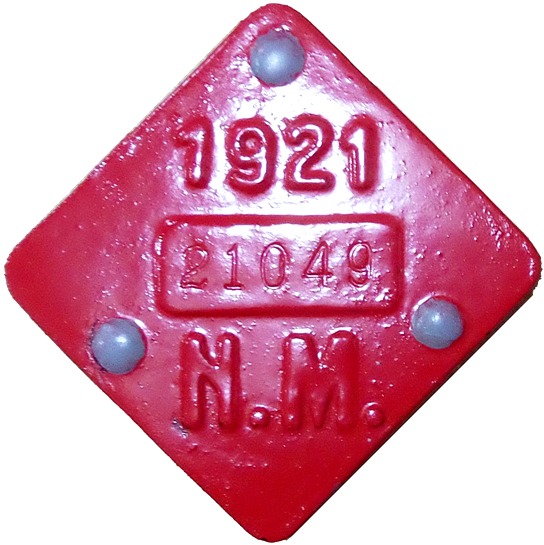

This was an unfortunate occurrence, as there are more than enough genuine tabs in circulation to put on all of the New Mexico porcelains worthy of display. But now one must be wary of every tab seen, and give it close inspection. Fortunately, the fakes are not particularly well done. All of the ones that we’ve seen have been cast rather than stamped, and their features are not as clear and sharp as on genuine tabs. They also make a distinctly different sound when dropped on a hard surface. Generally, a side-by-side comparison with known genuine tabs will quickly identify the fakes. Photos courtesy Greg Gibson.
Plates Falsely Claimed to Be
“Restored in the Correct Colors”
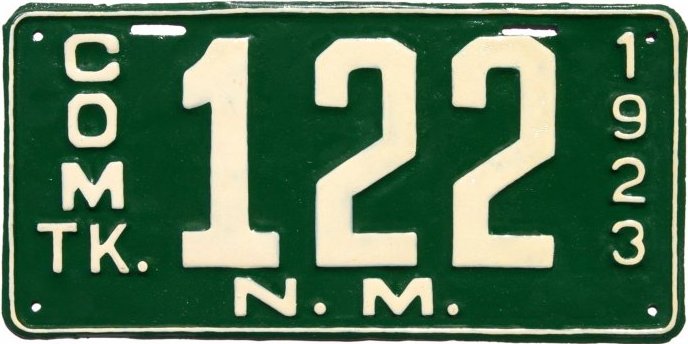
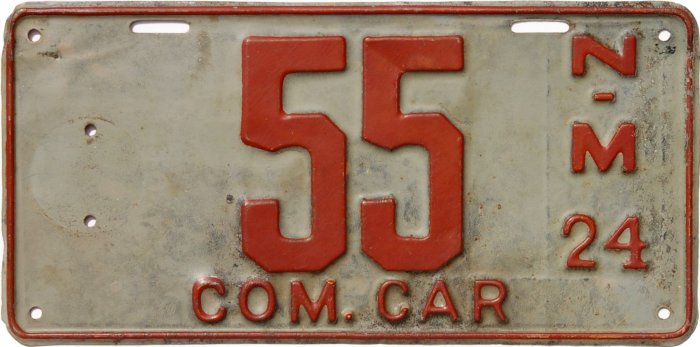
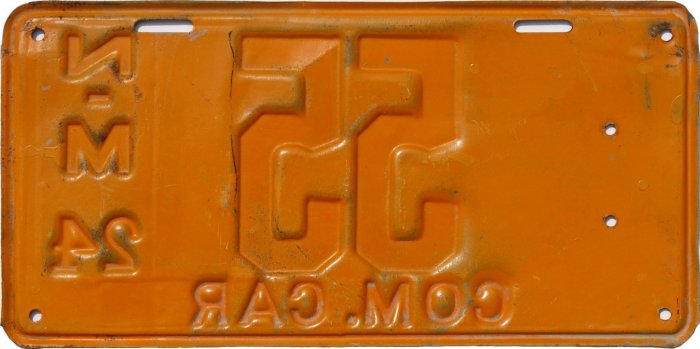
Though not illustrated here, 1924 Commercial Car plates are usually found
to be incorrectly repainted in white-on-black colors.
Claimed to Be
Vintage Bicycle Tags
|
|
|
|
||||
|
Wheaties Cereal Toy Plate |
Post
Cereal Toy Plate |
Actual N.M. Bicycle Tag |
A representative assortment of the toy plates is shown here:
https://nmplates.com/CerealAndGumPremiums.htm
And a similar assortment of genuine bicycle tags can be seen here:
https://nmplates.com/Bicycle.htm
Vintage Motorcycle Plates
The distinguishing characteristic which uniquely identifies the two types is that Motorcycle plates for these years had the letter “M” for a prefix, whereas the boat plates had a numeral for a prefix, that numeral designating the maximum number of passengers authorized to be carried by the boat. Because of their otherwise identical appearance, the uninformed might be forgiven for mistaking the boat plates for motorcycle plates, and putting them up for sale as such.
Examples of 1958 boat and motorcycle plates are shown above, and examples of other years may be seen at:
https://nmplates.com/Boat.htm
and
https://nmplates.com/Motorcycle.htm
“Professionally Restored”
Illustrated above is such a plate, along with an enlargement of a portion of it showing the abhorrent condition of the plate underlying the paint. At best, this plate cannot be considered to be “restored” at all, and the most charitable description would classify it a very poor amateur repaint.
“Rare”
Generally speaking, there is nothing to be gained by informing the seller that a plate so described is not in fact rare, but quite common. The response you’ll get is likely to be something like, “Well, I never saw one before, so it has to be rare.”
The best you can do is ignore it and hope that there are no buyers out there who get snookered because they are as unknowledgeable as the seller.
Low-Number Passenger Plates
Low-Number Passenger Plates
That they are Commercial plates is made obvious by the two pre-punched holes on the right side. These are the rivet holes for mounting of the weight/capacity tab that each commercial vehicle received, photos of which can be seen here: https://nmplates.com/CPrefix.htm. One even sees examples where the rivet holes have been filled in and painted over in an attempt to hide the fact that the plate being offered is a Commercial plate rather than a Passenger plate.
The majority of the excess 1931 Commercial plates in circulation today came from the same source, to wit, a building in the Santa Fe area that had used them as shingles. Examination of these plates will show that many of them have one or more small extra holes in them from being nailed to the building. In the 1980s we acquired about two hundred of these plates (which included some other types in addition to the Commercial tags) and made them available to other collectors. In the years since they have passed through multiple hands, with a substantial number of the ending up in the possession of persons who now place them on internet auction sites, falsely claiming that they are “low number passenger plates,” while demanding exorbitant prices for them.
Having County Numbers for Counties That Don’t
Exist
And this is another case where it may not pay to dispute the seller, as doing so could lead to a conversation along these lines:
| “I have a 1931 New Mexico plate
from county 68 that I want to sell.”
“Thanks but I don’t need a 1931 plate. But, by the way, New Mexico wasn’t using county numbers in 1931. That’s just part of the serial number.” “ Yes it is the county number. It says right here “county 68.” “It has the word ‘county’ on it?” “No, but it says ‘68.’ That’s the county number.” “Well, New Mexico never had more than 33 counties, so what county is 68?” (Angrily) “I don’t know what county it is but I’ve lived here all my life and I know these old plates have county numbers! You’re just trying to cheat me out of this plate.” “No I’m not. I already told you that I don’t need a 1931 plate.” “Well, you’re sure not going to get this one!” “Thank you.” |
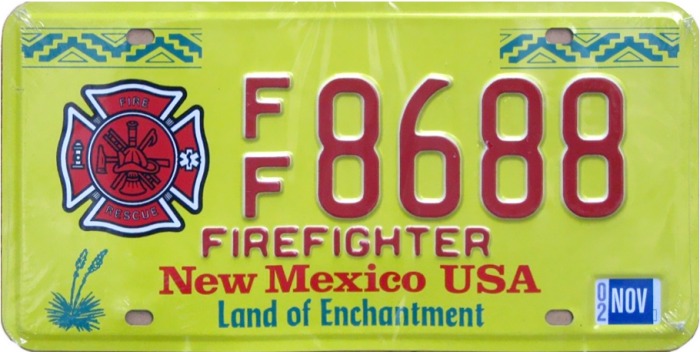
clearly don’t belong on the plates being sold. Realistic counterfeits are rare, but it’s common to see stickers from states other than New Mexico which do not bear
the name of any state, in other words, stickers which appear to be generic in nature. New Mexico does not use any stickers of this type, and since 2001 (with a
few exceptions for 2001 and 2002) all of her stickers are black on white, and bear both the state name and a serial number which matches that of the plate itself.
This is true not just for Passenger car plates, but for all types of non-Passenger plates, including even Vanities.
If you see one of these black-on-white stickers whose serial number does not match the plate number, you will know that the sticker is either counterfeit, or has
been transferred from a different plate. The only exception are permanent plates whose stickers bear the word PERMANENT or the abbreviation PRM.
For an overview of most types of stickers which have been issued since they first came into use in 1960, see:
https://nmplates.com/Stickers.htm
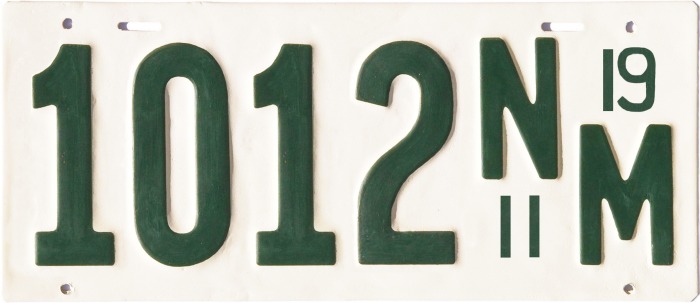
| First, New Mexico did not begin issuing license plates until 1912, so there were no 1911 plates issued by the state (or Territory), so such a plate never could have existed in the first place. | ||
| Second, the number on the plate is too high. At a time when motor vehicle registrations were approximately doubling each year, New Mexico had only 904 registered vehicles in 1912, so even if there had been plates issued in 1911 the highest plate number would have been no greater than about 450. | ||
| Third, the hoax photo was of a well known 1913 plate, and made use of a well known existing photo of that plate. That existing photo had clearly been altered with photo editing software, and clumsily so, as the “19” and “11” show no similarity to the dies of the plate serial number and show no relief. The additional characters are just digital images which had been pasted onto the original photo. |
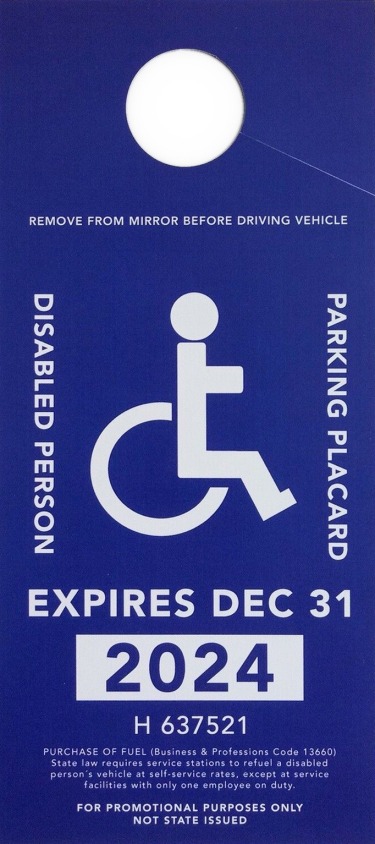
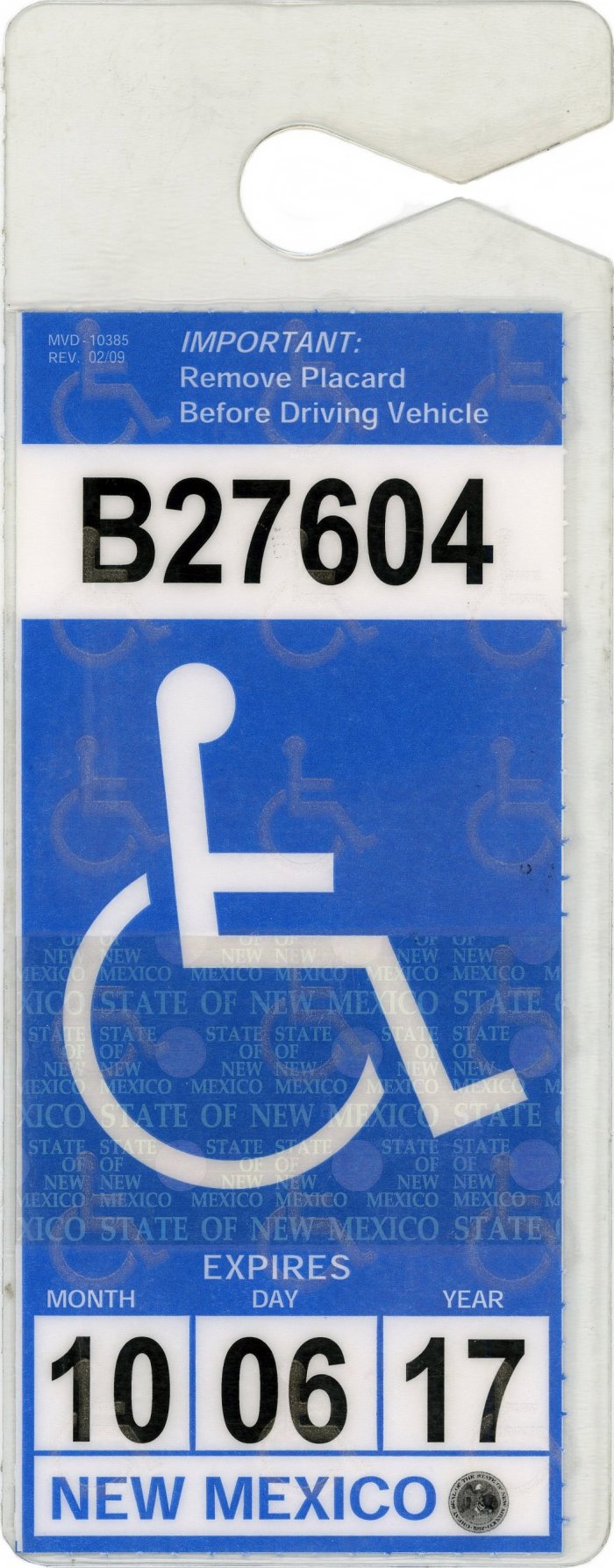
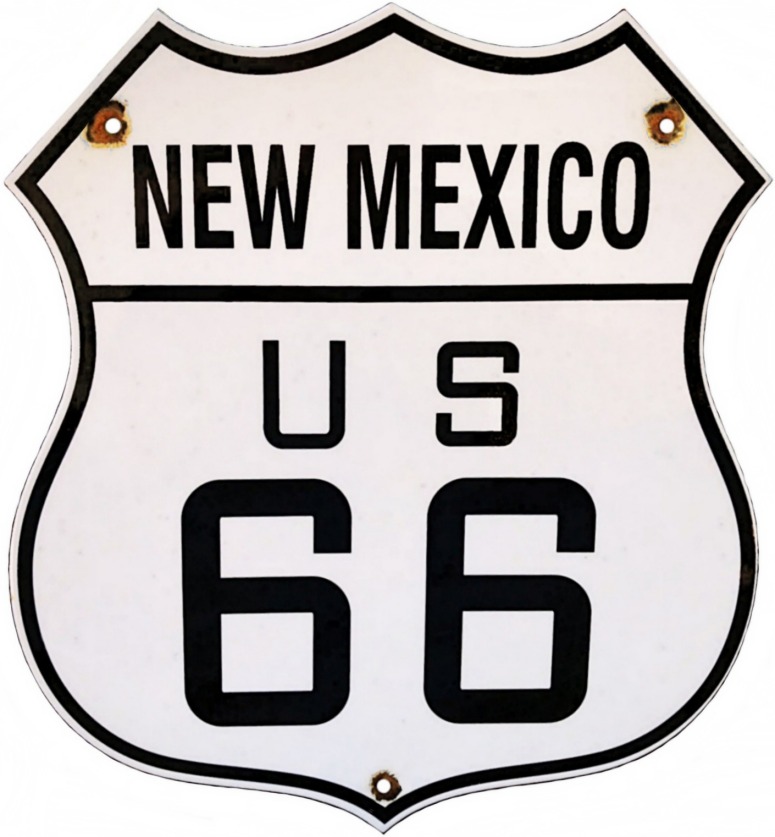 |
|
Fake |
Genuine |